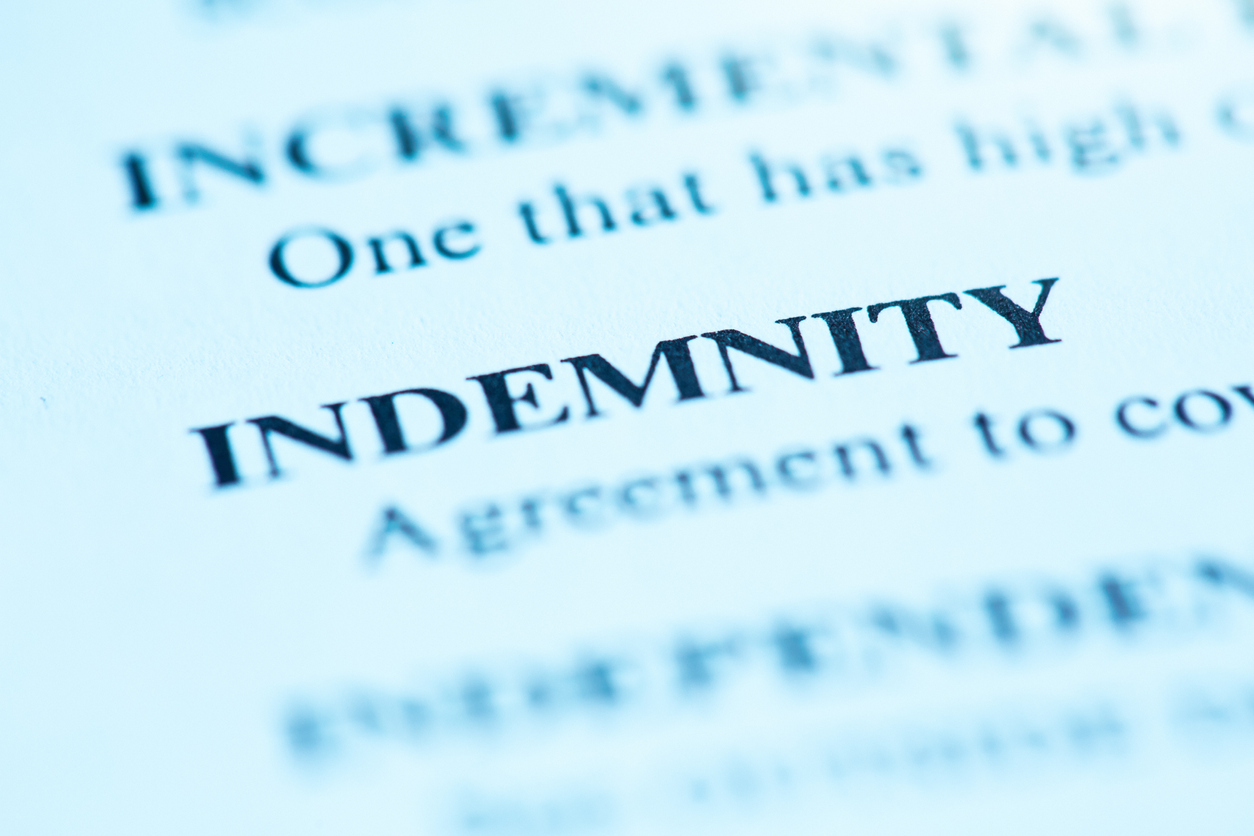What does it mean when we say that a property insurance policy is a contract of indemnity? This phrase was often mentioned when older cases analyzed the term “actual cash value.” The concept seems to get lost with the marketing of replacement cost policies. My impression is that we have allowed “actual cash value” to be valued less today because modern insurance practitioners do not understand the term indemnity.
I quoted a Tennessee Supreme Court case struggling with the concept of indemnity when considering the meaning of “actual cash value” in yesterday’s blog, Should Depreciation Be Taken on Partial Losses When Determining Actual Cash Value? It stated this:
A fire insurance contract is a contract of indemnity. Its purpose is to reimburse the insured; to restore him as nearly as possible to the position he was in before the loss.1
The lingering question is: How does one get placed in nearly as possible the same position before the loss as after? Further, shouldn’t the requirement be that a policyholder is not left in a worse position after the loss than before? This critical concept of a policyholder not being left in a worse position is why a number of states historically would not allow depreciation to be taken in a policy that only paid on “actual cash value,” and the parties contemplated a repair of a partial loss.
Many modern insurance educators miss this entire conceptual history when studying the terms. An example is a course offered by the Academy of Insurance, Actual Cash Value: How to Define an Undefined Term. The presenter, Crystal Uebelher, is extremely bright but only graduated from law school in 2007 and worked for an insurance defense firm. Her presentation centered on property insurance cases discussing case law about actual cash value over the last 20 years. The older cases and treatises discussing indemnity in an insurance age where only actual cash value policies were sold were never analyzed. The above concept that indemnity should not allow the policyholder to be in a worse position with an actual cash payment was not taught.
A remarkable discussion of this was in Indiana. A lower court appellate case decided in 1979,2 which was later vacated, noted:
A fire insurance policy is a contract of indemnity whereby the insurer, in exchange for a money consideration (premium), undertakes to make the insured whole for the loss of insured property caused by fire. First National Bank v. Boston Insurance Co. (1958), 17 Ill.App.2d 159, 149 N.E.2d 420; Butler v. Aetna Ins. Co. (1934), 64 N.D. 764, 256 N.W. 214. It has also been stated that the ‘contract of the insurer is not that, if the property is burned, he will pay its market value; but that he will indemnify the assured, that is, save him harmless, or put him in as good a condition, so far as practicable, as he would have been in if no fire had occurred.’ Washington Mills Manuf. Co. v. Weymouth Ins. Co. (1883), 135 Mass. 503, 506-507.
Since it is well settled that the concept of indemnity underlies every fire insurance contract, it is clear the indemnity pervasively affects the interpretation and operation of loss payable clauses in such contracts. While Indiana courts have not had occasion to pass on the meaning of the loss payable clause here disputed, courts in other jurisdictions have considered the meaning of the phrase ‘actual cash value’ in the context of similar contracts and factual settings.
Note how old the cases were in the discussion. Those older policies were sold when replacement cost policies were not available, and even selling them was illegal in many states. The appellate court then noted cases where depreciation was not allowed in this context of indemnity and actual cash value:
In Fedas v. Insurance Co. of State of Pennsylvania (1930), 300 Pa. 555, 151 A. 285, the Supreme Court of Pennsylvania reviewed an action on a fire insurance policy for the partial destruction of a dwelling and household goods. The clause in the policy was identical to that in the case at bar except the measure of loss was ‘ ‘(a)ctual cash value (ascertained with proper deductions for depreciation) . . . .’ ‘ Notwithstanding the mention of depreciation in the policy, the court held that actual cash value means what it would cost to replace a building or a chattel at the date of the fire. The court reasoned that in the case of a partial loss the determination of actual cash value must consider the use and function of the property and its integral position in an entire structure. Since the policy contemplates a recovery sufficient to repair or replace the property as nearly as possible to the condition as of the date of the fire, the payment of a lesser amount would defeat the essential indemnifying purpose of the policy. See, e. g.: Farber v. Perkiomen Mut. Ins. Co. (1952), 370 Pa. 480, 88 A.2d 776; Metz v. Travelers Fire Ins. Co. (1946), 355 Pa. 342, 49 A.2d 711.
In Glens Falls Ins. Co. v. Gulf Breeze Cottages (1949), Fla., 38 So.2d 828, the Florida Supreme Court considered the measure of indemnity for a loss to a ten-year-old roof caused by hailstorm and hurricane. The court said actual cash value meant the amount of money required to make the most economical repairs so as to place the roof as nearly as possible in the same condition existing before the loss, without allowing depreciation for materials used. See also: Sperling v. Liberty Mutual Insurance Company (1973), Fla., 281 So.2d 297, (fire loss).
This case was vacated when the issue went to the Indiana Supreme Court.3 The Indiana Supreme Court allowed a measure to be considered which allowed for depreciation to be a consideration in the context of adopting the broad evidence rule:
The insurance industry provides two distinct types of casualty protection for dwellings. One insures to the extent of the ‘actual cash value,’ i.e., the diminution in value; and the other insures to the extent of ‘the full cost of repair or replacement without deduction for depreciation,’ i.e., without regard to whether or not the restoration results in an enhanced value to the premises. This is an overly simplified explanation but adequate for purposes of resolving this case. Under some circumstances the amount payable following a loss may be the same under either insuring provision, but the risk assumed by the insurer and consequently the premiums charged are quite different.
…
The actual cash value policy is a pure indemnity contract. Its purpose is to make the insured whole but never to benefit him because a fire occurred. Appleman on Insurance 2d…; Brand Distributors Inc. v. Insurance Co. of North America, (1976) 532 F.2d 352 (4th Cir.). Replacement cost coverage, on the other hand, reimburses the insured for the full cost of repairs, if he repairs or rebuilds the building, even if that results in putting the insured in a better position than he was before the loss.
If a fire occurs in a new building, the actual cash value generally is equivalent to the cost of repairs since the full cost of repair merely restores what was there. It indemnifies but does no more. If an old building burns to the ground, the actual value is commonly established by reference to its fair market value less the value of the land on which the building sits. If an old building has only very minor fire damage, repairs probably do not result in a substantial betterment, and depreciation is usually ignored in adjusting the loss. However when the building is old or obsolescent and is seriously damaged but not destroyed, the actual cash value is more likely to be disputed. The courts uniformly hold, as did the Court of Appeals, that actual cash value insurance is strictly a contract of indemnity. The insured should be made whole but not be put in a better position than he was in before the fire.
This Indiana Supreme Court case, which adopted the Broad Evidence Rule allowing the trier of fact to consider using a “replacement cost minus depreciation,” is worth reading and will be analyzed in greater detail tomorrow. Note that it stated: “Under some circumstances the amount payable following a loss may be the same under either insuring provision” when considering differences between actual cash value and replacement cost.
The bottom line in this lesson is that indemnity is a term often overlooked or not properly discussed in today’s analysis of actual cash value. As a result, many of today’s cases construing “actual cash value” often result in lowering how much should be paid when only “actual cash value” is owed. Indeed, even insurance regulators, not fully appreciating how indemnity was historically an important part of actual cash value determination, have wrongfully allowed insurers to re-write what actual cash value means into policy definitions.
I also suggest that readers of this blog consider becoming a member of the Academy of Insurance. The lessons are excellent, and the price is right.
Thought For The Day
The farther backward you can look, the farther forward you are likely to see.
—Winston S. Churchill
1 Braddock v. Memphis Fire Ins. Corp., 493 S.W.2d 453 (Tenn. 1973).
2 Travelers Indem. Co. v. Armstrong, 384 N.E.2d 607 (Ind. App. 1979).
3 Travelers Indem. Co. v. Armstrong, 442 N.E.2d 349 (Ind. 1982).




